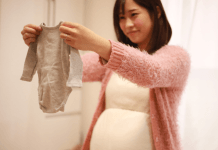 Three letters that could make any mom cringe. RSV or Respiratory Syncytial Virus is medical jargon for lots of coughing, wheezing, and a whole lot of mucous. Of course we took our four month old to the pediatrician at the first sign of illness (and then every other day for a week and a half…TWICE), but there is no specific treatment for RSV so unfortunately you just have to buckle in and wait it out. Lucky for you, we’ve come up with a few tips to help you survive along the way.
Three letters that could make any mom cringe. RSV or Respiratory Syncytial Virus is medical jargon for lots of coughing, wheezing, and a whole lot of mucous. Of course we took our four month old to the pediatrician at the first sign of illness (and then every other day for a week and a half…TWICE), but there is no specific treatment for RSV so unfortunately you just have to buckle in and wait it out. Lucky for you, we’ve come up with a few tips to help you survive along the way.
- Nose Frida. The only thing more amazing than what we lovingly refer to as the “super snot sucker” is how such a tiny human being can product so much snot. You’ll be equally grossed out as you are extremely proud of how much snot you literally suck right out of their nose. Tip – use saline solution first to soften the mucous making it easier to extract.
- Cool Air Humidifier. We had this running in my son’s room nonstop. The moisture in the air helps to break up the congestion and mucous in their chest. You can also sit in the bathroom with the doors shut and turn the hot water on high. The steam really helped with my son’s coughing, and I pretended I was relaxing in a sauna. It’s a win-win for everyone involved.
- Vicks BabyRub Soothing Ointment. Put a small dab on your child’s feet to open up the airways. You can also use essential oils for the same effect.
- Roll up a towel and put it under the mattress in your child’s crib. The incline will help with the drainage of all the snot.
- Breathing treatments. These are NOT FUN. Consider yourself warned. My son had a particularly bad case of RSV, but he responded well to the Albuterol from the treatments so we bought the machine and sang and danced around like lunatics to keep him entertained for those painstakingly long 8 – 10 minute sessions every four hours.
- Make sure you have a good thermometer to monitor their temperature. RSV can escalate quickly so you want to make sure they don’t have a crawling fever.
RSV symptoms typically peak around day four or five before they start to subside. If at any time you feel like your child isn’t improving or starts wheezing/having trouble breathing, call your pediatrician immediately. They will check oxygen levels and make sure your little one isn’t working too hard to breathe or potentially send you to the hospital for closer monitoring. RSV is scary and has been rampant this season. If you are the unfortunate mama of a child who contracts RSV, hopefully these tips will help get you through what will likely be a rough two weeks.













